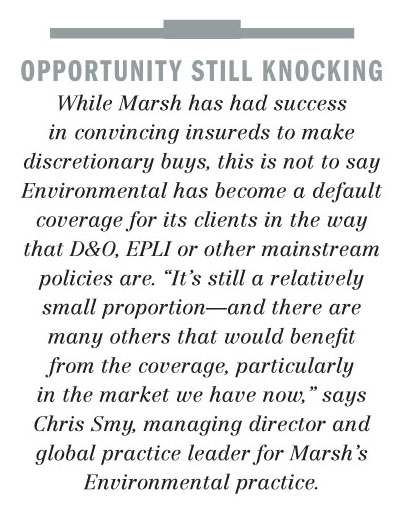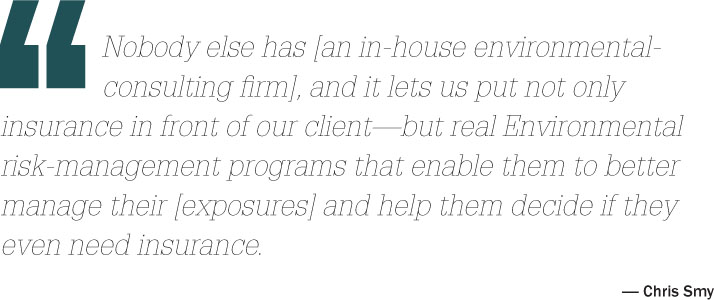The standard rap on Environmental insurance is thatorganizations only purchase it when they have to—required either byregulatory bodies or lenders to secure the coverage. That, in fact,was precisely the assessment of the line recently conveyed toPC360-NU by the chief underwriting officer at a topPollution carrier.
|But it’s a different story for at least some of the clients ofMarsh, the dominant Environmental brokerage. “I can see why [that]perception would be there, but it’s a dated statement” thatinsureds rarely make discretionary buys, says Chris Smy, managingdirector and global practice leader for Marsh’s Environmentalpractice. “A lot of organizations now are focusing on the potentialfor their operations to cause environmental damage and on theirpotential to experience loss—and they are proactively managing thatusing insurance.”
|One of the secrets in getting its clients to consider theirEnvironmental exposures is the way Marsh handles the delicateconversation around the “P” word: Pollution.
| “If you went to an elementary school andtasked a group of seven-year-olds to draw pollution, you might seepictures of factories with smokestacks,” Smy says. “And that visionof pollution means for a lot of entities that they really don’tperceive they’re going to impact the environment to the extent thatthey would need a Pollution policy.
“If you went to an elementary school andtasked a group of seven-year-olds to draw pollution, you might seepictures of factories with smokestacks,” Smy says. “And that visionof pollution means for a lot of entities that they really don’tperceive they’re going to impact the environment to the extent thatthey would need a Pollution policy.
“Whereas, can they have mold? Absolutely,” he continues. “Couldthat mold affect people and create losses? Yes, it can. So it’salmost like you have to take the term pollution out of thediscussion, because pollution makes you defensive: ‘Oh no, ofcourse we don’t pollute—we’re a very respectableorganization.’”
|So Marsh structures the dialogue around terms like“environmental impairment” and “environmental impact.” And thisapproach is working.
|“When I look at our own statistics, what we’re seeing is quitesatisfying,” says Smy. “Our strategy is to engage all our clientsin thoughtful discussions around their operations and what theirEnvironmental risks are and give them insight into howEnvironmental losses can occur—and it is working.”
|In addition to the traditional businesses that have long securedcoverage—real estate investment trusts, contractors andwaste-management firms—Marsh’s book of Environmental business today“runs the whole gamut of industries,” says Smy: health-care,higher-education, hospitality, pharmaceutical, technology,life-sciences and communication entities all have elected topurchase the coverage.
|DAY-TO-DAY DANGERS
|in addition to certain industries showing increased interest inthe coverage, another trend is helping expand placementpossibilities.
|Historically, Environmental has been a transactional-drivencoverage, often related to a merger and acquisition. Potentiallycontaminated property was changing hands, and the parties to thedeal wanted protection against future Pollution Liabilityassociated with the transfer.
|While the need for this type of coverage still drives many aplacement, “we are very deliberately looking for ways to have theconversation with our clients around their operational risk,” saysSmy.
|That is, businesses not only need to realize that what they didin the past has created potential liability, but they also need tothink about “what they are doing today and how does that poseliability for them,” he says. “That has been a [focused] strategyof ours—and one that has really changed the dynamic of our bookfrom what was predominantly transactional-based to what is nowpredominantly operational-based.”
|As one example of this operational risk, Smy pointed touniversities. “The dorms where students are living can have moldissues; colleges can have waste-management issues and fuel-storageissues; their labs may be handling radioactive materials. There arereally an awful lot of Environmental risks. They may not becatastrophic exposures, but they can be significant.”
|Another example of operational risks moving toward the fore canbe found in big-box retail stores—for which, in years past,Environmental coverage would only have crossed their radar if theywere developing a piece of real estate that might have had a pastcontamination.
|“Regulators are going after them really hard,” says JamesVetter, a senior member of Smy’s team with a special expertise inthe retail, wholesale and food-and-beverage industries. “There havebeen a large number of high-profile fines levied against theseretailers for how they manage waste—like what do you do with thegas in a lawn mower when it has been returned? [Those fines] havejust been earth-shaking, relative to losses in an industry youtypically wouldn’t think of as having a lot of Environmentalexposure. But they’ve been dealing with literallymultimillion-dollar claims and cleanups.”
|
THE CULTURE QUESTION
|in terms of how marsh differentiates itself from thecompetition, Smy doesn’t discount the benefits of his group’ssize.
|“We are one of the largest producers of Environmentalinsurance,” he notes. “We’ll [handle] more than 1,500 placements ayear—that’s a lot of placements, and there’s a lot of learning inthere” about trends in pricing, terms and conditions, andendorsements.
|“Based on the size of our book, we have some uniquerelationships with insurance carriers that enable us to get thebest deals for our clients,” says Smy.
|Another unique value proposition: Marsh has a centralizedplacement facility based in Chicago that handles a large proportionof its transactions and enables markets to come to Marsh and accessbusiness they want to write in a very centralized way. “Thatcreates a very competitive environment, and our clients benefitfrom that,” Smy says.
|And with 40 or so professionals in its Environmental practice,Marsh has one of the largest Environmental staffs in theindustry—and one populated with executives with extensiveexperience (and advanced degrees) in environmentalscience.
|But Smy says he is always reminding himself that biggest doesn’tautomatically mean best. “If I’m a client sitting in Philadelphia,it may be nice to know that Marsh has 40 people—but really I’mtalking to one person. So the experience I’m receiving is in thatone person’s head, and they’ll know what they know and won’t knowwhat they don’t know.
|“So what we do as a practice—and what I’m particularly proudof—is we’ve created a culture where you’re never speaking to thatone person,” he notes. “We’ve eliminated the barriers [that can beposed by internal] competition so that we’re truly operating in acollaborative environment. The learning and experience is shared sowe know what the best deal looks like from a client’s perspective.People are not afraid to say, ‘I don’t know the answer to that, butI can find it fast.’”
|IN-HOUSE EXPERTISE
|a big edge for marsh, in its view, is that clients can accessits dedicated, in-house environmental-consulting firm, Faulkner& Flynn (F2).
|“Nobody else has this, and it lets us put not only insurance infront of our client—but real Environmental risk-management programsthat enable them to better manage their [exposures] and help themdecide if they even need insurance,” says Smy. “This reallyelevates us above our competition.”
|“Everyone in the advisory firm has boots-on-the-groundexperience dealing with client technical issues,” says Drew Flynn,executive vice president of F2 and a certified geologist. In anyclient engagement, he adds, “we first identify and quantify whatthe risks are that they’re dealing with. Then we advise clients toeither help them better manage those risks or work with ourcolleagues within the Environmental practice to figure out anappropriate risk-transfer mechanism—insurance or otherwise.”
|Flynn points to a consulting engagement performed on behalf of aclient considering buying a manufacturer with multisite operationsin Canada.
|“We came in and [analyzed] the two categories of risk involved,”explains Flynn. “First, for operational risks, we looked at thefacility permitting and the history of violations and spills, andwe were able to advise the client as to how the practices of thistarget acquisition stacked up against its peers.
|“Second, because this was an older operation, we looked also atthe legacy risks. The [target company] had incidents of pollutionon-site, and they had been a waste generator contributing tolandfills and other disposal sites. So we were able then to helpthe client quantify what the legacy risks were and what the optionswere for dealing with those.”
|While other brokerages could partner with an outside consultingfirm to offer similar services, Marsh sees two advantages to havingthis capability internally.
|When seeking strategic risk advice, “many clients have apreference to get that from one source and not have to try and takethe deliverables from multiple entities and somehow weave thattogether into a perspective on what they need to do,” says Smy.
|Adds Elizabeth Bannister, a senior member of Marsh’sEnvironmental practice who specializes in construction-relatedrisks: “Many times the very specific technical data that clientsare getting from a consulting firm is required for deals we need toturn around very quickly. So having this in-house capability meansif a nondisclosure agreement is already in place, then F2 can becovered by that, avoiding the delays that bringing in adisassociated third party can cause.”

Want to continue reading?
Become a Free PropertyCasualty360 Digital Reader
Your access to unlimited PropertyCasualty360 content isn’t changing.
Once you are an ALM digital member, you’ll receive:
- All PropertyCasualty360.com news coverage, best practices, and in-depth analysis.
- Educational webcasts, resources from industry leaders, and informative newsletters.
- Other award-winning websites including BenefitsPRO.com and ThinkAdvisor.com.
Already have an account? Sign In
© 2024 ALM Global, LLC, All Rights Reserved. Request academic re-use from www.copyright.com. All other uses, submit a request to [email protected]. For more information visit Asset & Logo Licensing.








